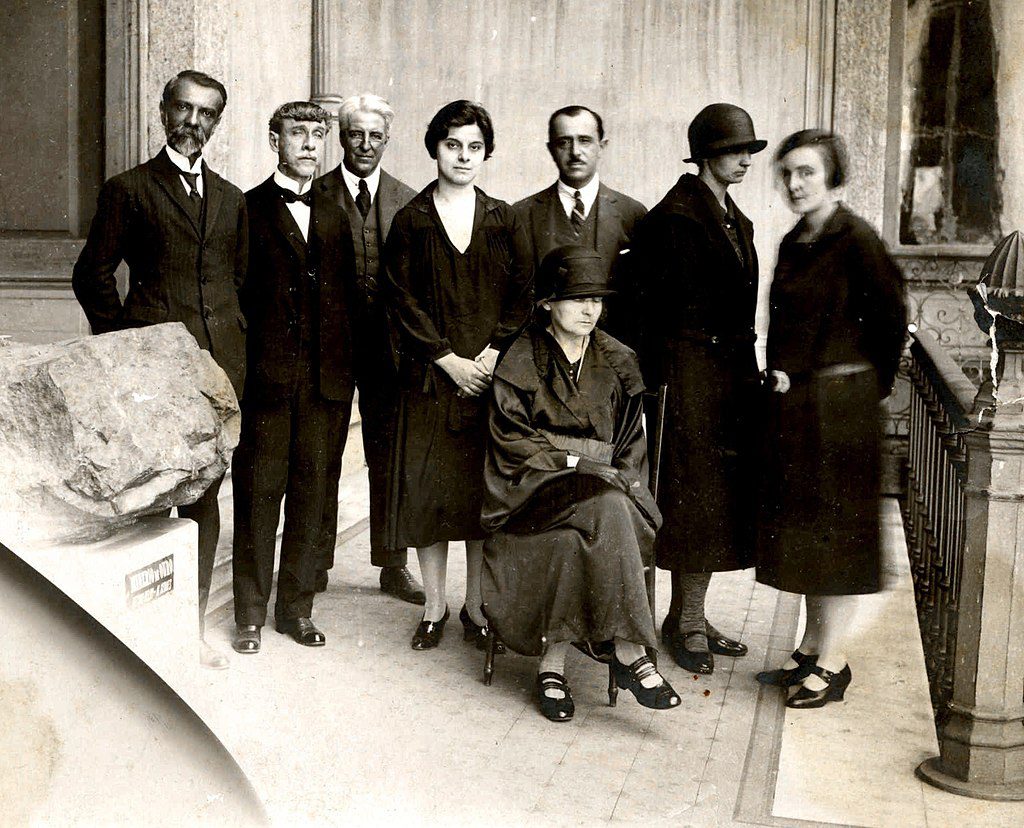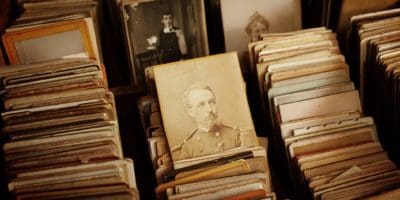Top 15 Interesting Facts about Marie Curie
*Originally Updated by Natalie in February 2020 and Updated by Vanessa in October 2022
If you visit Paris today you can head to the Pantheon in the 5th arrondissement. Inside, you’ll find the tomb of one of the most important minds ever to have graced the French capital: Marie Curie.
Marie Curie was a Polish born scientist who was single handedly responsible for one of the most significant scientific discoveries of all time: radiation. During her time in Paris, Curie was able to detect the harmful rays that come from uranium, and the way in which said rays can pass through solid materials.
Getting to this point was no easy venture for Curie. Not only was she incredibly poor, but she was also a woman, two characteristics not taken very seriously in the world of science at the time.

Marie Curie – by Henri Manuel – Wikimedia Commons
1. Marie Curie Moved to Paris in 1891
Contrary to popular belief, Marie Curie wasn’t French. She was born Marie Sklodowska in Warsaw, Poland in 1867 to two schoolteachers who raised her with little money in poverty stricken neighborhood.
Sklodowska took an interest in science from an early age, and was a noticeably smart child. By the age of 24, she had saved enough money to get herself to Paris, where she enrolled in Sorbonne University on the Left Bank.
It was here that her scientific mind was really allowed to thrive.
2. Marie Curie and Her Husband Were a Force to be Reckoned With
At age 28, Marie Sklodowska got married to a man named Pierre Curie. He was a professor in the physics department at the Sorbonne University where she was studying.
The two were a match made in heaven; Marie with the mind to change the course of history, and Pierre with the means to help her do so.
Marie actually went by her full name: Marie Sklodowska Curie. She never kept Poland far from her heart, and even hired tutors to teach her daughter Polish growing up. It is said that even her discovery of the element Polonium was named after her homeland.

Pierre and Marie – by Smithsonian Institution – Wikimedia Commons
3. Albert Einstein Became her Biggest Fan
Pierre was tragically killed in a road accident in 1906. By 1911, Curie had thrown herself deep into her work but was hardly getting the recognition she deserved.
She attended the Solvay Conference in Brussels; a conference that brings together the world leaders of physics, of which Curie was the only woman present.
It was here she met Albert Einstein for the first time. France was, at the time, at its peak with sexism, xenophobia, and anti-semitism. Curie was being excluded from all spaces in which she could outshine any male counterparts which sent her into deep depression.
It was around this time when Einstein took it upon himself to reach out to Curie by sending a thoughtful letter, noting that he was totally impressed and inspired by her drive and intellect. He implored her to keep working, to keep fighting and to know that there are people behind her.

Albert Einstein – by Famlmdjr – Wikimedia Commons
4. In Earlier Years, Marie Curie Often Fainted from Hunger
During her first few years in Paris, Marie Curie attended her university classes by day, and worked as a tutor by night.
She had so little money that she survived only on tea and buttered bread. She would often faint from hunger and lack of nutrients, only to get right up again and continue with her day.
5. Marie Curie Coined the Word “Radioactivity”
It was in 1898 that Curie discovered that thorium was a radioactive substance. However, Gerhard Schmidt took the liberty to publish Curie’s discovery as his own.
Luckily, around this same time her husband Pierre decided he would join his wife in her work, and later in 1898 they were ready to publish their own findings of a new element called Polonium.
By December, the pair were ready to announce the existence of a second element: radium. In the publication of this finding Curie used the word “radioactivity”, and the rest is history.

Marie Curie – by Fotograv – Wikimedia Commons
6. Curie Got Involved in Aiding Soldiers of the First World War
At the outbreak of WW1, Curie was completely dissatisfied with the presence of science on the front lines. She saw that soldiers often needed urgent care and operations, but Xray machines were inaccessible close to battle.
Curie designed mobile radiography units by installing Xray machines into cars along with generators. These could be deployed on site and help save hundreds of lives as destruction occurred.
She made 20 of these vehicles, all operated by a team of women, and then went on to install 200 more at field hospitals. It is estimated that Curie saved over 1 million lives with this initiative.

Curie in a mobile xray unit – by Unknown author – Wikimedia Commons
7. The Nobel Prize Committee Initially Ignored Her
It was in 1903 that Curie’s work was submitted to the Swedish Academy for Nobel Prize consideration. Pierre Curie and Henri Becquerel had been part of her works, and so all three names were included on the submission.
During these sexist times, the department for prize consideration decided to exclude Curie from all mentions associated to the discoveries.
It was a sympathetic member of the awards committee who took initiative and attempted to make things right. His name was Gösta Mittage-Leffler, and he wrote a private letter to Pierre Curie warning him of the committees bad intentions.
Pierre made contact with the organization and expressed how Marie Curie was absolutely vital to the studies existence and that their work was not possible without her. Later that year, Curie became the first woman in history to be awarded the Nobel Prize.
8. She is the Only Person to Ever Win Nobel Prizes in Different Sciences
Pierre Curie was killed shortly after they received the Nobel Prize in physics. By 1910, Curie was deep in a new avenue of discovery; one that took her into the field of chemistry.
Curie managed to isolate radium, and she then defined an international standard for radioactive emissions which she aptly named “the curie”.
A year later, her discoveries warranted the award of a second Nobel Prize, this time in the field of chemistry! No one had or has ever won Nobel Prizes across two different sciences.
9. Marie Curie’s Daughter Also Became a Nobel Prize Winner
Following in her parents footsteps, Marie and Pierre’s eldest daughter Irène was awarded a Nobel Prize of her own in 1925.
Her work remained in the field of radioactivity, and her discoveries included the synthesis of new radioactive elements.

Pierre, Marie and Irene – by Unknown – Wikimedia Commons
10. Curie’s Work Eventually Killed Her
In 1934 Curie checked into a treatment center in Passy, Paris, where her intent was to rest and regain strength.
On July 4th Curie passed away from what was later determined to have been aplastic anemia. This is the result to extensive exposure to harmful radiation, which at the time was not known to be a threat to human beings.
Curie spent most of her career carrying test tubes of radioactive isotopes in her pockets, as well as in her desk drawers. It is likely that all of her possessions and paperwork held immense radioactive energy that would eventually lead to her demise.
Today, all of Curie’s original paperwork is kept in special containers and may only be handled with protective gear.
11. Marie Curie had to look for women’s alternative education

Marie Curie by Fotograv from Wikimedia Commons
Maria had aspirations of enrolling in university studies at the University of Warsaw with her sister Bronia after receiving her high school certificate. The twins enrolled at Flying University, a Polish university that accepted female students, as the school did not accept women.
In order to avoid being discovered by authorities at the time because higher education for women was still prohibited, the institution frequently changed locations. Maria relocated to Paris to live with her sister in 1891, and to further her education, she enrolled at the Sorbonne.
12. Only Marie Curie has won Nobel Prizes in two different fields

Marie Curie by Museu Nacional from Wikimedia Commons
Marie Curie made history in 1903 when she and her husband, Pierre, along with physicist Henri Becquerel, won the Nobel Prize in physics for their research on radioactivity, making her the first woman to do so.
Even more significant was the second Nobel Prize she won in 1911 in the field of chemistry, making her the first recipient of the honour twice. She continues to be the only individual to have ever won Nobel Prizes in two distinct fields.
13. The Periodic Table has two new elements thanks to Marie Curie
Marie Curie’s research and discovery of the elements polonium and radium were rewarded with the second Nobel Prize she was awarded. The first element was named after the Latin word for ray, while the second element was a tribute to Poland, the author’s own land.
14. Marie Curie spent the majority of her time working in a shed
Marie Curie put in countless hours of physical effort for the research that earned her the first Nobel Prize. She and her husband had to break down ore into its chemical constituents in order to make multiple instances of the new elements they had identified. They shifted their operations inside an abandoned shed outside the school where Pierre works because their regular labs couldn’t fit the technique. Curie claimed that the area had a glass roof that didn’t completely shield them from the rain, making it feel like a hothouse in the summer and draughty in the winter.
15. A psychic medium was once the subject of Marie Curie’s investigation
Marie and Pierre Curie participated in research into Eusapia Palladino, an Italian medium who claimed to be able to communicate with the dead, and they went to a number of seances two years after Marie and Pierre Curie were awarded the Nobel Prize in Physics.
Pierre appeared to believe that some of Palladino’s tricks, such as levitated objects and tables, were authentic. (Marie didn’t seem to be as convinced.)
Planning a trip to Paris ? Get ready !
These are Amazon’s best-selling travel products that you may need for coming to Paris.
Bookstore
- The best travel book : Rick Steves – Paris 2023 – Learn more here
- Fodor’s Paris 2024 – Learn more here
Travel Gear
- Venture Pal Lightweight Backpack – Learn more here
- Samsonite Winfield 2 28″ Luggage – Learn more here
- Swig Savvy’s Stainless Steel Insulated Water Bottle – Learn more here
Check Amazon’s best-seller list for the most popular travel accessories. We sometimes read this list just to find out what new travel products people are buying.











